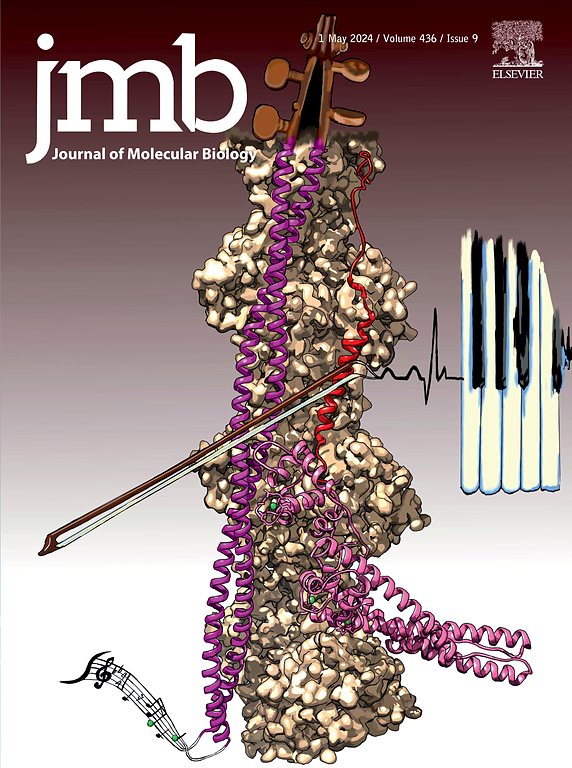TGT通过反密码子环中基本位点的形成破坏其底物trna。
IF 4.7
2区 生物学
Q1 BIOCHEMISTRY & MOLECULAR BIOLOGY
引用次数: 0
摘要
RNA修饰是调控活细胞中基因表达的一种公认的方法。天然酶修饰RNA已经被描述了几十年。最近,更多与RNA损伤相关的其他机制已经出现,这些机制不涉及靶向酶活性,但却改变了核苷的化学结构。异常修饰的RNA也可能由于不完全或错误的酶促反应而出现。我们证明了细菌和真核生物中的trna -鸟嘌呤转糖基酶(TGT)意外地离开底物trna反密码子环的RNA碱基位点(rAP)。rAP位点的形成是TGT催化机制的一部分,涉及到n -糖苷键的裂解,以及共价酶- trna加合物的形成。rAP位点形成的现象很容易被细菌中的tRNATyr(GUA)和真核生物中的tRNAAsp(GUC)检测到,并且当细菌中preQ1的供应受损时被放大。tgt介导的trna中rAP位点的积累受到应激的强烈诱导,尤其是在细菌的氧化应激中。细菌中的多聚体分析指出,在翻译核糖体部分中部分排除了含有rap的tRNA,促使人们考虑这些tRNA物种是“受损”的,很可能是无功能的。对小鼠rAP tRNA(GUN)位点的探索性分析显示,不同组织之间存在很大的差异,在脑、肺和脾脏中观察到的受损tRNA积累最多。总之,这些结果揭示了一种独特的RNA修饰分子机制,通过一个可能错误的反应,削弱而不是增强RNA的功能。本文章由计算机程序翻译,如有差异,请以英文原文为准。

TGT Damages its Substrate tRNAs by the Formation of Abasic Sites in the Anticodon Loop
RNA modification is a well-recognized way for gene expression regulation in a living cell. Natural enzymatic RNA modifications have been characterized for decades. Recently, additional mechanisms, more related to RNA damage, have emerged, which do not involve targeted enzymatic activity but nonetheless alter the chemical structure of nucleosides. Aberrantly modified RNA may also appear due to incomplete or erroneous enzymatic reactions. We demonstrate that tRNA-guanine transglycosylase (TGT) in bacteria and eukaryotes accidentally leaves RNA abasic sites (rAP) in the anticodon loop of substrate tRNAs. The formation of an rAP site is a part of the TGT catalytic mechanism, involving the cleavage of the N-glycosidic bond, and the formation of a covalent enzyme-tRNA adduct. The phenomenon of rAP site formation is readily detectable for tRNATyr(GUA) in bacteria and tRNAAsp(GUC) in eukaryotes and is amplified when the supply for preQ1 in bacteria is compromised. The TGT-mediated accumulation of rAP sites in tRNAs is strongly induced upon stress, and most prominent upon oxidative stress in bacteria. Polysome profiling in bacteria points out the partial exclusion of rAP-containing tRNAs from the translating ribosome fraction, prompting a consideration of these tRNA species as “damaged” and most likely non-functional. The exploratory analysis of rAP tRNA(GUN) sites in mice demonstrates a substantial variability among different tissues, with the highest accumulation of damaged tRNA observed in the brain, the lung and the spleen. Altogether, these results uncover a unique molecular mechanism of RNA modification that, via a presumably erroneous reaction, diminishes RNA function rather than enhancing it.
求助全文
通过发布文献求助,成功后即可免费获取论文全文。
去求助
来源期刊

Journal of Molecular Biology
生物-生化与分子生物学
CiteScore
11.30
自引率
1.80%
发文量
412
审稿时长
28 days
期刊介绍:
Journal of Molecular Biology (JMB) provides high quality, comprehensive and broad coverage in all areas of molecular biology. The journal publishes original scientific research papers that provide mechanistic and functional insights and report a significant advance to the field. The journal encourages the submission of multidisciplinary studies that use complementary experimental and computational approaches to address challenging biological questions.
Research areas include but are not limited to: Biomolecular interactions, signaling networks, systems biology; Cell cycle, cell growth, cell differentiation; Cell death, autophagy; Cell signaling and regulation; Chemical biology; Computational biology, in combination with experimental studies; DNA replication, repair, and recombination; Development, regenerative biology, mechanistic and functional studies of stem cells; Epigenetics, chromatin structure and function; Gene expression; Membrane processes, cell surface proteins and cell-cell interactions; Methodological advances, both experimental and theoretical, including databases; Microbiology, virology, and interactions with the host or environment; Microbiota mechanistic and functional studies; Nuclear organization; Post-translational modifications, proteomics; Processing and function of biologically important macromolecules and complexes; Molecular basis of disease; RNA processing, structure and functions of non-coding RNAs, transcription; Sorting, spatiotemporal organization, trafficking; Structural biology; Synthetic biology; Translation, protein folding, chaperones, protein degradation and quality control.
 求助内容:
求助内容: 应助结果提醒方式:
应助结果提醒方式:


